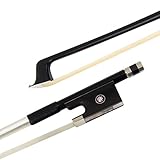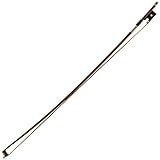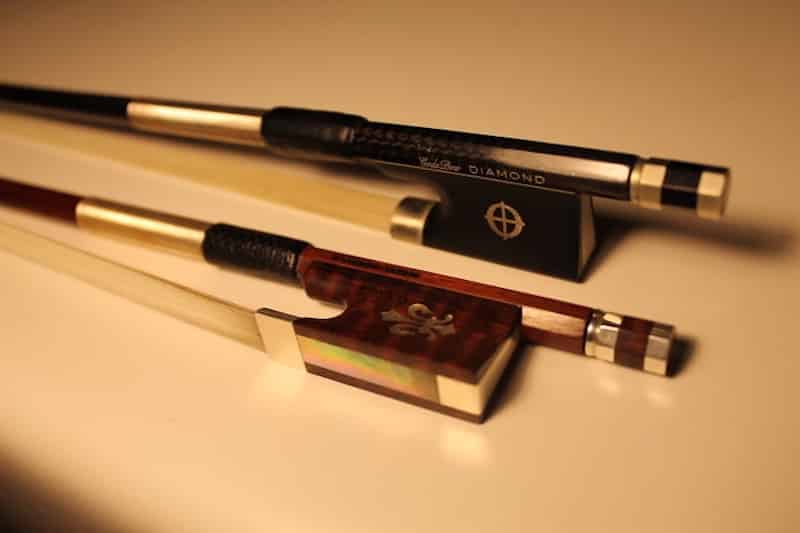Are you looking for a new violin bow? Wondering which ones are best and which ones will break after a few weeks? Whether you’re a beginner or an aspiring professional, finding the right violin bow for your playing style and ability is crucial to getting a good sound out of your violin.
In this post, we’ve made a list of what we think are the best violin bows currently on the market and a variety of different price points to help you get the best one for your budget.
Quick Answer: The Best Bows for Violins








The Best Rated Violin Bow Reviews
Before we get to our violin bow buying guide for those of you that have questions, below, we’ve listed our violin bow reviews of some of our favorites to help inspire you about which one might be best for you.
1. CodaBow Diamond GX Carbon Fiber Violin Bow
- 4/4 violin bow
- Kevlar acoustic core
- Traditional Frog made from Polished Premium Ebony by Walter Paulus
This violin bow is best suited for professionals or those looking to play the violin as a career. This bow is expensive, but its craftsmanship is worth the investment.
This carbon fiber bow mimics the sound of the coveted Pernambuco bows. Pernambuco has consistently been the best wood for bow construction, but they wear out much faster than carbon fiber bows.
CodaBow has an extensive list of bows available, but only the highest quality is in their Diamond range. What sets these bows apart is their top-notch carbon fiber. Traveling violinists love their carbon fiber bows because they are not as susceptible to humidity or weather damage as wooden bows.
A few other perks of the CodaBow Diamond GX:
- Kevlar acoustic core
- Polished Xebony frog – not made from endangered ebony
- Bow hair does not come from endangered or regulated species
This bow also comes with a lifetime warranty that protects you from paying for craftsman-related damage.
2. CodaBow Prodigy Carbon Fiber Violin Bow
- 4/4 Violin Bow - Graphite Diamond Weave Finish - Blended Acoustic Core - Brown Tint
- Traditional Frog Design Made by Walter Paulus with Xebony Engineered Ebony - Sterling Silver Winding - White Mother-of-Pearl Slide
- Nickel and Silver fittings - Moroccan Leather Grip - Metal Alloy Tip Plate - Silver Medal Horse Hair - Traditional Hand-Cut Wood Wedges and Plugs
Delivering smooth, balanced play without the Diamond price, the Prodigy is an ideal bow for an up-and-coming player perfecting their craft.
The Prodigy does not skimp on quality materials, however. It has a mother-of-pearl slide and Sterling Silver winding, along with the Xebony frog featured on the Diamond GX.
CodaBow created the Prodigy for pre-professional players, so it’s more forgiving than more luxurious models. The Prodigy is lightweight and comfortable, providing more range of movement and a smoother glide.
Other features of the Prodigy include:
- Moroccan leather grip to prevent calluses
- Silver medal horsehair
- Hand-cut wood wedges and plugs
Unlike the Diamond, the Prodigy only has a five-year warranty against manufacturing faults – something to keep in mind if you expect a lot of wear and tear.
Many reviewers say they love this bow for its ease of use and how it sounds during double stops and staccato.
3. Fiddlerman Wood and Carbon Fiber Hybrid Violin Bow
- HIGH QUALITY & HAND-MADE: Professional quality arch for exceptional action and rebound. High carbon composite stick delivering superior resonance and...
- MADE TO LAST: Unaffected by humidity and temperature fluctuation - excellent for traveling musicians.
- TOP TIER MATERIALS: Made with quality Siberian horsehair & durable cowhide leather wrap. Quality ebony frog delivers excellent vibration transfer from...
If you want a heavenly sound without the cost, this bow should be at the top of your list. This bow delivers the high-quality sound that you may expect to see in some of the more expensive models.
Advertised for beginners and intermediate players, this is a practical option for middle or high school violinists that plan to continue their studies.
Fiddlerman crafted the Hybrid bow to give players the authentic wooden bow feel and the much-loved, bright carbon fiber sound. Since there is some wood in this bow, it is vulnerable to damage from humidity and temperature – make sure your violin case has a thermometer in it!
More features of the Fiddlerman Hybrid:
- Siberian horsehair
- Copper-mounted ebony frog
- Arched for good bounce and movement
This bow is fun to use and gives a clean sound for beginner violinists. Several reviewers say that this bow is what violin teachers and tutors recommend for their more committed students.
4. Vio Music #709 Old German Baroque Style Violin Bow
- Beautiful Sankewood Stick, 4/4
- Genuine White Mongolian Horsehair
- Master Old German Baroque Style
Inspired by the days of yore, this bow is unique in appearance and sound. It represents the Old German-style bows.
This bow is Snakewood and shorter than the standard bow to accommodate the Baroque style of music, such as Vivaldi and Bach.
The tip of the Vio Old German bow is elongated to accent the Baroque emphasis on the downbow. Traditionally, Baroque bows were lightweight to give a lighter, springier sound.
This bow is a spectacular addition to your collection if you want to play more Baroque music or learn a new technique.
Some other reasons why you may want to give it a try:
- Genuine white Mongolian horsehair
- 58 grams – lighter than the previous bows on this list
- Customized for Baroque style
Since this bow is so unique and engineered for a specific style, it’s not as beginner-friendly. The Vio Baroque bow is better suited for professionals or enthusiasts looking to expand their repertoire.
5. Fiddlerman Carbon Fiber Violin Bow
- HIGH QUALITY & HAND-MADE: Professional quality arch for exceptional action and rebound. High carbon composite hollow stick delivering superior...
- MADE TO LAST: Unaffected by humidity and temperature fluctuation - excellent for traveling musicians.
- TOP TIER MATERIALS: Made with quality Siberian horsehair & durable cowhide leather wrap. Quality ebony frog delivers excellent vibration transfer from...
The Fiddlerman Carbon Fiber Bow is the ideal practice bow. Differing from the Fiddlerman Hybrid, it is only carbon fiber.
Despite its affordability, the Fiddlerman Carbon Fiber model does not lack in quality. This bow looks sharp and professional and by no means appears cheap.
Additional notes on the Fiddlerman Carbon Fiber bow:
- Flexible for even bounce and movement
- Genuine Mongolian horsehair
- Double-wrapped leather grip
- Copper-mounted ebony frog
Performers like this bow for practice and outdoor performances because it will not warp like a Pernambuco bow. Beginners enjoy it for its price, look, and balanced feel.
Like the other Fiddlerman bow, teachers recommend this bow for beginning students due to its price and durability. This bow will withstand regular use and won’t warp if young students leave it outside or damage it.
6. Viotti Carbon Fiber Violin Bow
- SUPERIOR QUALITY TUNED TO YOUR BUDGET: This premium carbon violin bow offers quick response & bright, focused sound at a very affordable price....
- HANDMADE BY EXPERT PROFESSIONALS: Unlike mass-produced bows, your Viotti carbon fiber bow is carefully crafted – by hand – by skilled violin & bow...
- ONLY THE FINEST MATERIALS: From its ebony frog to its white Mongolian horse hair, this exquisite black bow is built for years of use. Weighs between...
This bow describes itself as stiff and well balanced, so it’s perfect for violinists with a tendency to slide all over the fingerboard while bowing.
The Viotti Carbon Fiber bow is handcrafted and not mass manufactured. It would make a spectacular starter bow, as the well-padded grip on the frog makes bow-hold learning a breeze.
The Viotti bow also offers the following:
- Mongolian horsehair
- Ebony frog
- Ships in a professional bow case
We think this bow is the top pick for young players, but it’s a decent bow for every skill level. However, with weight ranging from 58 to 62 grams, be sure to purchase a lighter one for smaller arms.
Reviews of the Viotti bow are generally positive, with most people saying it’s a quality investment for all skill levels and performs well.
Note that, due to the cost, the carbon fiber is mostly plastic. It will not feel as high-quality as the other carbon fiber bows mentioned but still delivers a bright and resonant sound.
7. VINGOBOW Brandnew Carbon Fiber Violin Bow
- Advanced Performance - Your Vingobow carbon violin bow is made by experienced bowmaker. It comes to you warm and clear tone. Peacock flow is manually...
- Natural Horsehair - We use unbleached Mongolian horsehair for the fiddle bow, enabling it to have great resilience, easier to be rosined.
- Good-Quality Carbon Fiber - The stick of the advanced carbon bow is stronger and more durable than Pernambuco, with well bounce and great flexibility....
Next to the Old German Baroque bow, the VINGOBOW Brandnew bow is one of the most unique on this list.
The bow hair is black. Black bow hair is not just there for aesthetic reasons – VINGOBOW suggests that the unbleached hair allows for a clear sound and is easier to rosin than lighter-haired bows.
Black hair is thicker than white horsehair, so the bow is sturdier and tightens quickly. VINGOBOW recommends this bow for advanced players due to its weight and quality.
VINGOBOW did not stop with the aesthetically pleasing black horsehair – they also added a few other benefits to the Brandnew Carbon Fiber bow:
- Silver-mounted ebony frog
- Colorful shell slide with a peacock flower pattern
- No gap between the stick and frog
This bow is best suited for professionals and advanced musicians, especially those that play outside or around big groups of people often. Electric violin players or rock musicians enjoy this bow immensely.
8. Kmise Stunning Blue Carbon Fiber Violin Bow
- Crafted using advanced molding techniques,the violin bow is constructed of carbon fiber and other modern materials,delivers a new level of performance...
- The way that this violin bow transfers string vibration to your fingertips makes you feel at one with your instrument, facilitating technique and...
- This violin bow looks great,thanks to an eye-catching abalone inlay and Parisian eyes.It is resistant to temperature and humidity, allowing you to...
Want to make an entrance? The Kmise Carbon Fiber bow is for you!
This bow comes in several different shades, but the stunning blue is the most vibrant. While it might seem like a bright blue bow is for kids and not high-quality, the Kmise bow is surprisingly bright in sound and loved by professionals and novices.
Parents purchase this bow for their children starting on violin often, so if you have a child beginning their virtuoso journey, the Kmise Stunning Blue bow makes a great option.
The bow is carbon fiber but does have other materials blended in. It has an abalone inlay and a traditional, genuine ebony frog. The carbon fiber blend of materials helps maintain balance and keep it at a lightweight 55 grams.
Reviews on the Kmise bow are slightly more polarized than the others on this list. Positive reviews repeatedly mention:
- Excellent value
- Sturdy
- Eye-catching compared to wooden bows
- Perfect for students
Negative reviews mention things like bow hairs falling off prematurely, tightening screws breaking or not loosening the bow enough, and low-quality sound.
9. HAOYUE Violin Bow
- 🎻 100% CARBON FIBER HAND CRAFTED BY PROFESSIONAL LUTHIERS- Carefully selected 100% carbon fiber has greater durability and longevity. Unlike wooden...
- 🎻 PERFECT WEIGHT AND BALANCE ("GOLDEN WEIGHT") - This bow achieves the "golden weight" of 59-62 grams. Ebony frog and screw with nickel silver...
- 🎻 HIGH QUALITY NATURAL HORSE HAIR - Natural Mongolian horse hair (unbleached) provides greater elasticity, strength and years of beautiful, sweet...
Minimalists, this bow is for you! Keep it simple-but-sharp with the HAOYUE carbon fiber bow.
With a carbon fiber stick and genuine horsehair, this bow competes with the high-end models on this list but at a way lower cost.
This bow weighs 60–62 grams and has a golden weight. Additionally, the bow hair is unbleached, so your sound won’t endure the impact of a chemically treated bow.
Some other positives regarding the HAOYUE bow:
- Bow comes with a matte black case for protection
- Ebony frog has natural wood grain detailing
- Fully lined frog
HAOYUE recommends this bow for beginner players and students. Most of the reviews are from beginners or teachers that say the weight is ideal for learning.
10. PAITITI Full Size Violin Bow
- Round Stick, Leather Bow Grip, Abalone Slide and Silver Color Plated Wire
- Brand new high quality Brazil wood round stick violin bow for beginners.
- AAA+ Mongolia Natural white horsetail and high quality ebony frog
If you’re on a tight budget but still need a decent quality bow, the Paititi is a solid choice. Unlike most of the others on this list, this bow is wooden.
The stick of the Paititi Full-Size bow is Brazilian wood, meaning that it can bend and possibly break in the humidity. If you live in an area with weather that’s mild, you should be fine.
This bow also has a rounded stick instead of carved or geometrically shaped. It’s soft to the touch to help new players adjust to holding the bow.
Most people that purchase this bow seem to buy it for children or students, as it’s affordable but made with decent materials. There are complaints of bow hairs snapping and falling off upon first use of the bow.
How to Choose a Violin Bow: Buying Guide
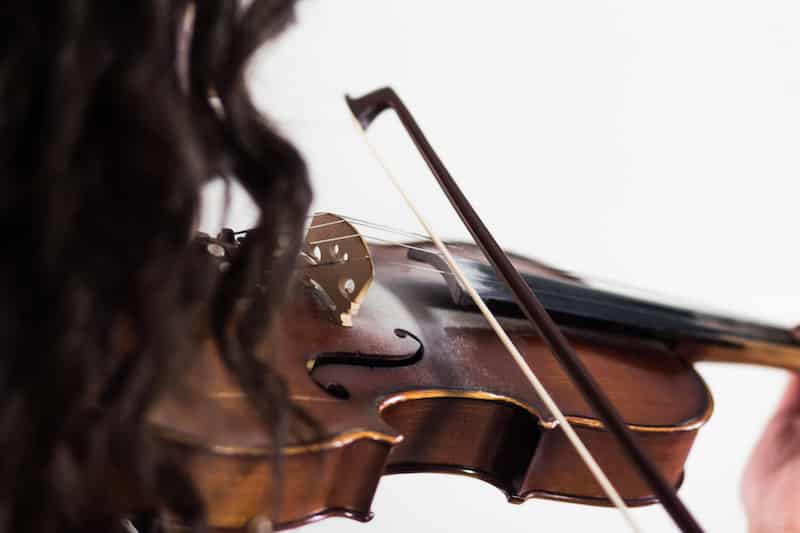
As a violinist, you have many products to choose from when you are searching for tools to improve your playing or violin.
When you are shopping for violin bows, for example, you will come across a variety of brands, bow types, and bow sizes.
The type of violin bow that you choose can have a tremendous effect on the sound that you produce with your violin and how comfortable you feel as you are playing your violin.
There are several things that you should know about as you are searching for a new violin bow and the below guide will help you to know what to look for when buying a new bow. Let’s start by looking at the materials.
Materials Used to Make Bows
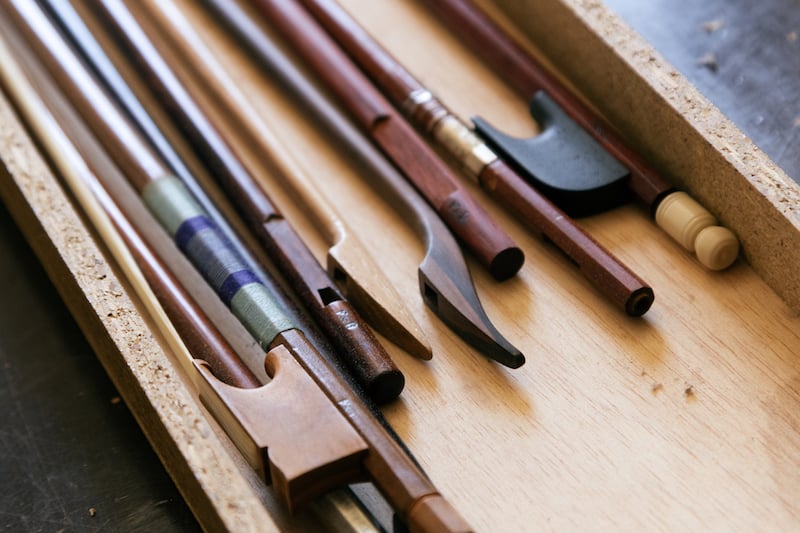
The bow of a violin is, in a simplified format, a stick with horsehair attached to two anchor points.
However, as you may already know, a violin bow is much more complex than this and there are several components that are involved in an entire violin bow.
There are several different materials that are used to construct the main part of a violin bow which are:
- Pernambuco wood
- Brazilwood
- Fiberglass
- Carbon fiber
Pernambuco wood
Pernambuco wood has been used to construct bows since the late 1700s and is typically used to make premium-quality violin bows.
It’s sourced from various regions in Brazil and has continually been used in violin bows due to its strength and additional physical properties.
Recent government regulations in Brazil, which have been put in place to reduce deforestation, have made pernambuco wood a rarity for many industries.
For these reasons, pernambuco wood violin bows are often higher-priced, high-quality, and well-constructed.
Brazilwood
Brazilwood, as hinted at by its name, is another type of wood that comes from Brazil.
However, manufacturers also use different types of wood from various other tropical climates to develop Brazilwood violin bows.
The quality of Brazilwood violin bows, due to the variety of woods that are used to construct the bows, can vary.
As a buyer, you will need to pay attention to the reviews of each Brazilwood violin bow that you may be interested in, as a result of the wide difference in qualities.
Fiberglass
Fiberglass is used on lower-end violin bows, providing a simple and affordable alternative for violinists.
Constructed with fiberglass materials, fiberglass bows are durable and are not very prone to the harmful warping effects that are caused by temperature changes and varying humidity levels that wooden bows face.
Fiberglass bows are especially great for beginner violinists because it allows them to learn the basics of their instruments without needing to invest too much money at first.
Carbon fiber
Carbon fiber is one of the lightest and strongest materials that exists and is an ideal option for violin bows.
Carbon fiber, however, is not a natural element and is developed by weaving long strands of carbon-based polymers together into intricate patterns.
Carbon fiber, as a result of its many great qualities, is primarily used in the automotive industry but rapidly branched its way out into other industries.
It’s currently used for many musical products, but violin bows are a staple product of the material.
Carbon fiber violin bows are typically lighter and stronger than the other bow types and are also less susceptible to damage, such as warping and breaking, than other types of violin bows.
As opposed to wood bows, violinists do not need to be as concerned about the effects that humidity and temperature will have on their carbon fiber bows.
Bow Shape
Violin bows are produced with sticks that have different shapes. The two stick shapes that you will find as you are searching for a violin bow are round sticks and octagonal sticks.
It is believed that both bow shapes produce different sounds from one another on a violin, which is a completely plausible belief due to the fact that bows with octagonal shapes are typically more rigid than bows with round shapes.
This leads us on to talk about violin bow rigidity.
Rigidity
The rigidity of a violin bow affects the clarity of the sound that a violin produces as bows that are more rigid tend to produce notes with more clarity.
However, a violin bow can also be too stiff, translating its physical characteristics into a rougher and more- rigid sound.
This isn’t to say that round bows are worse than octagonal bows.
In fact, most violin bow makers use round shapes when crafting their bows rather than octagonal shapes.
Bows that are less rigid are believed to produce more expressive sounds and sounds that are less rigid.
Bow Length
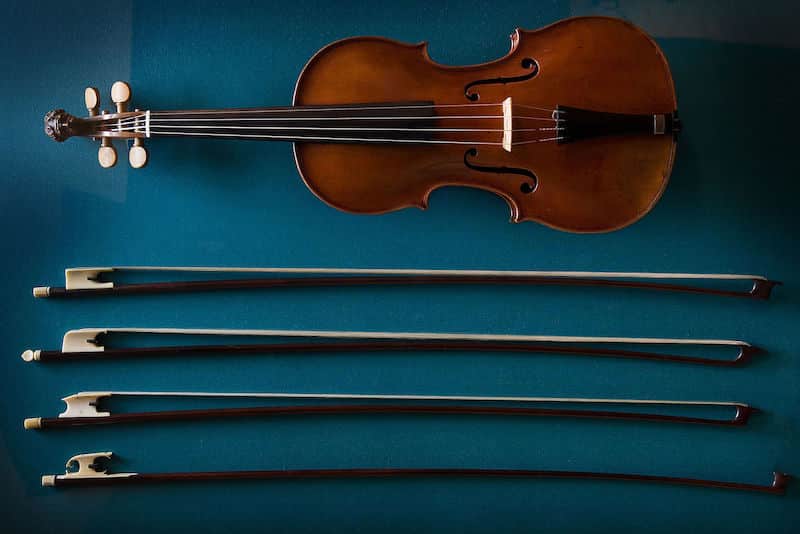
The length of the violin bow that you select will depend primarily on the size of your violin.
In the same way that you’ll choose the size of your violin depending on how big you are, the ideal length of a violinist’s bow also depends on the size of their body.
Violin bows can be as long as 30 inches in length and as short as 22 inches in length.
Although size doesn’t matter and you should pick one that fits you, the length of a violin bow does affect the rigidity of the bow.
Shorter bows are more rigid than longer bows due to the decreased amount of flexibility that the bows have as they are cut shorter.
Shorter bows, however, are easier to control than longer bows.
The difference in rigidity between the different bow lengths will translate into the sound that you produce with your violin.
Weight
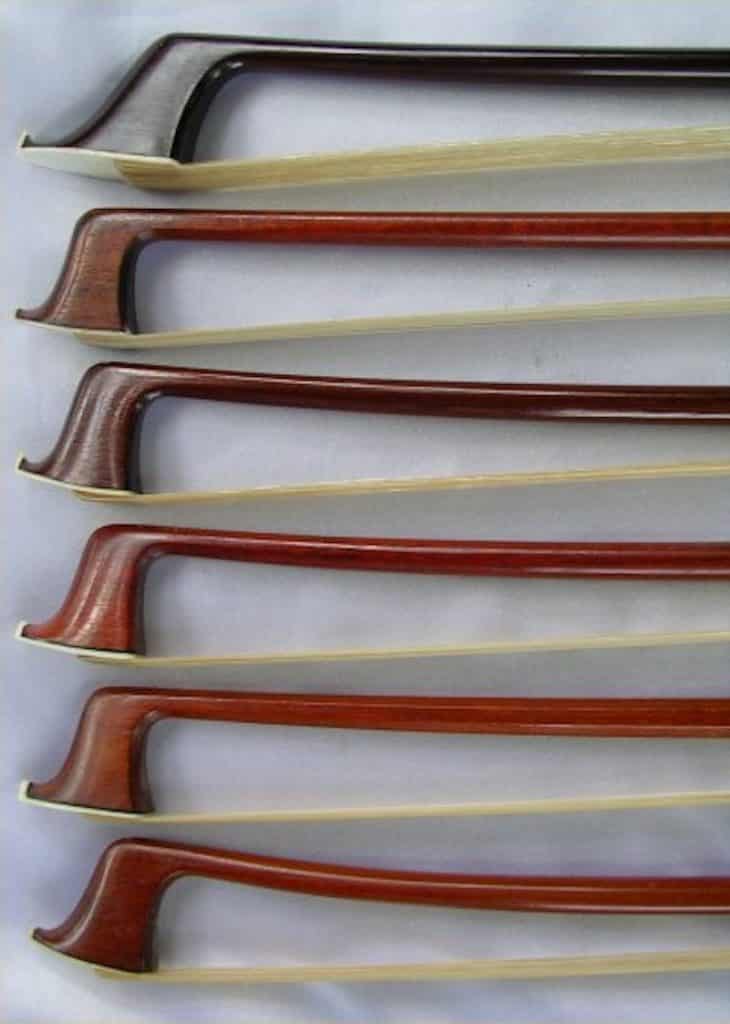
The weight of your violin bow will have an effect on the sound that you create with your violin and can also potentially affect your playing technique.
While violin bows do not vary too much in weight, with many bows ranging around 60 grams, the weight of a bow can be felt by the bow hand of a violinist.
For consideration, the average weight of a cello bow is around 80 grams, a difference that can certainly be felt when compared to a violin bow.
A heavier violin bow will allow you to place more weight onto the strings of your violin, which can help you if you want to draw more sound out of your violin.
In contrast, a lighter violin bow will allow you to remove weight from the strings of your violin as you play, which can be especially helpful to you when you are playing music with faster tempos.
Many professional violinists keep different weighted bows in their violin cases for these reasons.
Balance
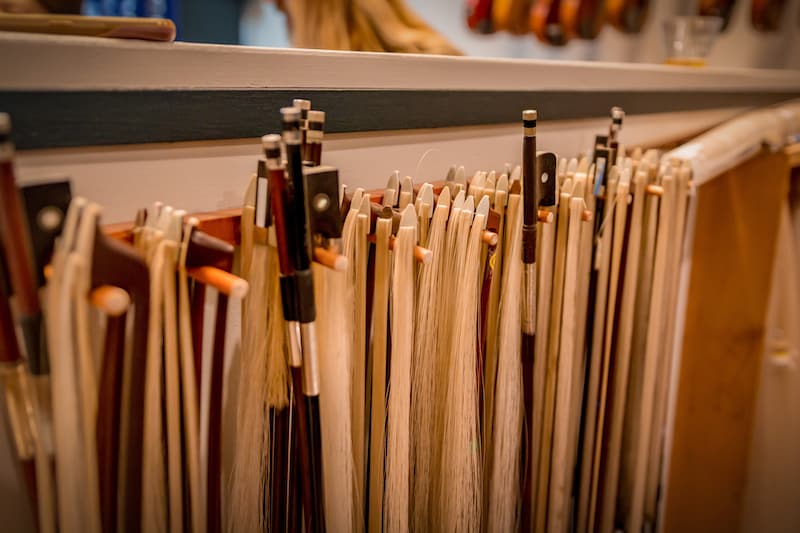
The balance of a violin bow is a decision-maker for many violinists.
When you hold a violin bow, its balance will determine how the rest of your bow hand forms around the bow.
Additionally, a bow’s balance can potentially affect your playing technique.
The weight distribution and balance of a violin bow is a personal preference.
Some violinists like violin bows that are heavier towards their tips, while other violinists prefer bows that have more weight towards the frog of the bows.
Similarly, some violinists prefer violin bows that are nearly even in their weight distributions.
As you test different violin bows, you will be able to feel what feels right for your bow hand.
Durability
The materials that are used to construct a violin bow, in addition to its actual construction, will determine how durable the bow is.
The durability of violin bows can vary very much due to the many materials that are used to construct violin bows.
Cheaper violin bows, which are typically made of fiberglass, Brazilwood, or plastic components, tend to be less durable than more expensive bows.
When shopping for durable and high-quality violin bows, pay attention especially to the frog of the bow.
If the frog of the violin bow is made with plastic, then the bow is a lower-quality bow.
Alternatively, violin bows with frogs that are made of ebony materials are typically higher-quality bows and are more durable as a result.
Budget

Violin bows can be found within a range of budgets, providing you with an expansive selection to choose from when looking for affordable options.
Fiberglass violin bows, which are available in many colors, are available for as low as $50. In contrast, the most expensive violin bow that has ever been sold was crafted by Francois Xavier Tourte, of the prominent Tourte French bow-making family, for a price that was close to $300,000.
You can purchase very good violin bows in the $100 to $300 price range.
While you may have to test more bows out and do some additional research, you can also find good violin bows that are between $50 and $100.
If you want a high-quality professional violin bow, then you will find numerous options above the $500 price point.
Common Violin Bow Makers
There are a multitude of violin bow makers to choose between while you are shopping for a new violin bow.
CodaBow, D Z Strad, and Fiddlerman are some of the most popular bow makers.
Among these three brands, you will find a selection of great bows for your violin.
Conlsuion: Which Bow Should You Buy?
Choosing the right violin bow for your needs may seem like a daunting task at first.
Research and take your time as you are shopping for your new violin bow, and if possible testing out each one that you are considering purchasing.
A violin bow can be a long-term investment for your career as a violinist and can have many positive effects on your skills and sound quality.
If you’re still on the fence about which one to go for, remember that which bow you buy depends on your skill level and how long you plan to continue playing.
If you’re a lifelong violinist that wants to continue for the extended future, one of the CodaBow options will probably be your best bet.
But, if you’re a beginner violinist just starting or working on a smaller budget, then a less expensive bow like the Fiddlerman bows or Kmise bow might work better for you.
- 4/4 violin bow
- Kevlar acoustic core
- Traditional Frog made from Polished Premium Ebony by Walter Paulus




